INSTITUT SUPERIEUR D'ANTHROPOLOGIE
INSTITUTE OF ANTHROPOLOGY
ONLINE COURSES / COURS A DISTANCE
WINTER TERM : JANUARY 2015
REGISTER NOW
ISRAËL – 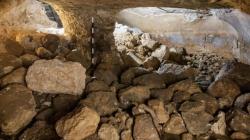 Beit Shemesh- Archaeologists working in the hills outside of Jerusalem uncovered an ancient ritual bath that offers not only remnants of Second Temple-era life in the area, but also those of Australian soldiers who visited the site while passing through during World War II. During a dig at the Elah junction south of Beit Shemesh, archaeologists found “fragments of magnificent pottery vessels,” such as lamps, a jug and cooking pots, that helped them date the use of mikveh, or ritual bath, back to the time of the Second Temple, but the evidence indicates that residents stopped using it as a ritual bath during the second century CE, “perhaps in light of the Bar Kokhba revolt,” according to Tsur. After the site ceased to be used as a mikveh, residents of the area enlarged the otzar — or water collecting vat for the mikveh — and continued to use it as a cistern for collecting drinking water. Nearly 2,000 years later, as fighting again raged in the region, two Australian soldiers left their names, ranks and identification numbers carved into the rock at the site during World War II.
Beit Shemesh- Archaeologists working in the hills outside of Jerusalem uncovered an ancient ritual bath that offers not only remnants of Second Temple-era life in the area, but also those of Australian soldiers who visited the site while passing through during World War II. During a dig at the Elah junction south of Beit Shemesh, archaeologists found “fragments of magnificent pottery vessels,” such as lamps, a jug and cooking pots, that helped them date the use of mikveh, or ritual bath, back to the time of the Second Temple, but the evidence indicates that residents stopped using it as a ritual bath during the second century CE, “perhaps in light of the Bar Kokhba revolt,” according to Tsur. After the site ceased to be used as a mikveh, residents of the area enlarged the otzar — or water collecting vat for the mikveh — and continued to use it as a cistern for collecting drinking water. Nearly 2,000 years later, as fighting again raged in the region, two Australian soldiers left their names, ranks and identification numbers carved into the rock at the site during World War II.
http://www.timesofisrael.com/ancient-bath-and-aussie-carvings-uncovered-at-archaeology-site/
USA – Araliq - Residents of the southwest Alaska village of Quinhagak are hoping ancient hair found at a nearby archaeological dig will yield information about possible ancestral ties. The hair and other genetic samples were among items preserved by permafrost that were found at the site of an ancient village 5 miles outside the Yup'ik community,Knecht said some hair samples went toward a study of indigenous Alaskans that was outlined this summer in the journal Science. The study was led by Danish researchers and concluded that modern Inuit people, including people in Alaska, descended from the Thule, who were on the scene about 700 years ago. The Thule replaced an earlier population called Paleo-Eskimos. The dig near Quinhagak is at the site of an ancient Yup'ik village that was called Araliq. Knecht said permafrost there preserved artifacts dating back 700 years and included wood and leather that normally would have disintegrated. The site contained a wealth of artifacts. "We're getting things like weapons and kayak parts, masks and artwork, things that you normally just see in museums," Knecht said. "And these all date from between about 1400 and 1600 AD."
http://www.newsminer.com/news/alaska_news/archaeological-dig-near-alaska-village-yields-ancient-hair/article_e07a8638-4b41-11e4-8e30-001a4bcf6878.ht
ROYAUME UNI – 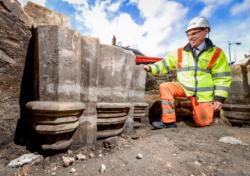 King’s Lynn - Ancient remains uncovered by roadworks on King’s Lynn’s Saturday Market Place will be reburied once archaeologists have finished recording them.A 14th Century charnel chapel was found alongside Lynn Minster during work on the square. The building would have been used to store the bones of the dead 600 years ago. Remains have been removed from the site, while further excavations have revealed more of the building’s structure.
King’s Lynn - Ancient remains uncovered by roadworks on King’s Lynn’s Saturday Market Place will be reburied once archaeologists have finished recording them.A 14th Century charnel chapel was found alongside Lynn Minster during work on the square. The building would have been used to store the bones of the dead 600 years ago. Remains have been removed from the site, while further excavations have revealed more of the building’s structure.
http://www.wisbechstandard.co.uk/news/ancient_remains_found_in_king_s_lynn_will_be_reburied_1_3797481
GRECE – 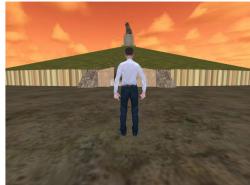 Amphipolis - With all the hype surrounding the excavations currently under way at ancient Amphipolis, a group of graphic designers have created a 3D video which transports viewers to the tomb itself, giving them some indication of what the Kastra hill looks like from within. The designers have carefully digitized official photos released by the Ministry of Culture over the last few months. Their video offers a virtual tour, taking viewers from the outside of the monument up to the wall of the third chamber. With keyboard arrows, viewers can virtually wander around the Kasta hill – just as archaeologists do in reality. You can watch the 3D animation here
Amphipolis - With all the hype surrounding the excavations currently under way at ancient Amphipolis, a group of graphic designers have created a 3D video which transports viewers to the tomb itself, giving them some indication of what the Kastra hill looks like from within. The designers have carefully digitized official photos released by the Ministry of Culture over the last few months. Their video offers a virtual tour, taking viewers from the outside of the monument up to the wall of the third chamber. With keyboard arrows, viewers can virtually wander around the Kasta hill – just as archaeologists do in reality. You can watch the 3D animation here
http://greece.greekreporter.com/2014/10/07/new-ancient-amphipolis-3d-video/?
ITALIE – 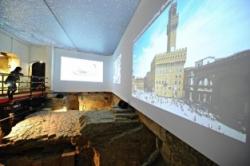 Florence - Palazzo Vecchio was built on the ruins of a theater from the times of the Roman Empire. Archeological excavations carried out for years by Archaeological Cooperative, under the scientific direction of Superintendence for Archaeological Heritage of Tuscany, revealed an ancient Roman amphitheater was located precisely under what is nowadays, and was during the Renaissance, the heart of Florence, Piazza della Signoria and Palazzo Vecchio. The discovery was announced during the UNESCO World Forum on Culture and Cultural Industries held in the Tuscan capital October 2-4. The excavations made it possible to bring back to light ruins of ancient thermal baths and other services related to an outdoor theater designed to accommodate 5,000 spectators. The excavation site will be open to the public. “The project is of great historical significance because it is the only complex of ancient Roman ruins that can be visited in Florence,” said Dario Nardella, mayor of Florence. In the Piazza della Signoria area, archeologists reveal, historical evidence dating as far back as 30 and 15 BC, the time when the Roman city of Florentia was founded, can be found.
Florence - Palazzo Vecchio was built on the ruins of a theater from the times of the Roman Empire. Archeological excavations carried out for years by Archaeological Cooperative, under the scientific direction of Superintendence for Archaeological Heritage of Tuscany, revealed an ancient Roman amphitheater was located precisely under what is nowadays, and was during the Renaissance, the heart of Florence, Piazza della Signoria and Palazzo Vecchio. The discovery was announced during the UNESCO World Forum on Culture and Cultural Industries held in the Tuscan capital October 2-4. The excavations made it possible to bring back to light ruins of ancient thermal baths and other services related to an outdoor theater designed to accommodate 5,000 spectators. The excavation site will be open to the public. “The project is of great historical significance because it is the only complex of ancient Roman ruins that can be visited in Florence,” said Dario Nardella, mayor of Florence. In the Piazza della Signoria area, archeologists reveal, historical evidence dating as far back as 30 and 15 BC, the time when the Roman city of Florentia was founded, can be found.
http://www.italymagazine.com/news/ancient-roman-amphitheater-unveiled-under-florences-piazza-della-signoria?
RUSSIE –  Belaya River - Researchers in Siberia have found the remains of a baby mammoth that researchers believe was caught and eaten by humans about 25,000 years ago, local media reported Thursday. The remains, discovered on the shores of Siberia's Belaya River, were separated into at least three distinct groups of chopped ribs, a broken skull and other bones, and teeth — all stacked over a 1.5-square-meter area, leading researchers at the Irkutsk State University to hypothesize that the animal fell prey to hunters, the Babr news agency reported. Researchers estimate that the bones, discovered earlier this month, are about 25,000 years old. Since the remains belonged to a young animal, researchers also believe that the mammoth was probably captured by hunters when it fell behind its herd, the report said. Archeologists digging up ancient human campsites in the village of Malta in the Irkutsk region also found the bones of a woolly rhinoceros this summer and a range of artifacts made from bone and stone, the report said.
Belaya River - Researchers in Siberia have found the remains of a baby mammoth that researchers believe was caught and eaten by humans about 25,000 years ago, local media reported Thursday. The remains, discovered on the shores of Siberia's Belaya River, were separated into at least three distinct groups of chopped ribs, a broken skull and other bones, and teeth — all stacked over a 1.5-square-meter area, leading researchers at the Irkutsk State University to hypothesize that the animal fell prey to hunters, the Babr news agency reported. Researchers estimate that the bones, discovered earlier this month, are about 25,000 years old. Since the remains belonged to a young animal, researchers also believe that the mammoth was probably captured by hunters when it fell behind its herd, the report said. Archeologists digging up ancient human campsites in the village of Malta in the Irkutsk region also found the bones of a woolly rhinoceros this summer and a range of artifacts made from bone and stone, the report said.
http://www.themoscowtimes.com/news/article/siberian-mammoth-unearthed-after-eaten-by-people-25-000-years-ago/507822.html
TRINIDAD & TOBAGO –  Banwari site - The Banwari Trace heritage site will be destroyed if the State continues its construction of the Debe to Mon Desir leg of the Sir Solomon Hochoy Highway extension to Point Fortin.Ramdahin is in Trinidad researching the potential archaeological disaster after learning about the controversy between the Highway Re-Route Movement (HRM) and the State. He visited the site yesterday, where, in 1971, the remains of a human dated to 7,000 years ago, was found. Ramdahin noted that the Banwari Trace Site was located about 200 metres away from highway construction works. He said the site was a marker for human civilisation where a society once thrived and there wa a high probability that the construction of the highway might impact the archaeological grounds, destroying it. Buried beneath the soil was the potential of new archaeological discoveries and artefacts, he said. The Banwari Trace Site was listed among the 100 top archaeological sites in the world and is a World Heritage Site. Ramdahin recommended that the State go back to the drawing board since in the planning stage of the Sir Solomon Hochoy Highway extension to Point Fortin, archaeological sensitivity was over-looked. Ramdahin believes the Banwari Site, is something the world can benefit from since it can give clues to the Amerindian and their migration patterns to other Caribbean islands.
Banwari site - The Banwari Trace heritage site will be destroyed if the State continues its construction of the Debe to Mon Desir leg of the Sir Solomon Hochoy Highway extension to Point Fortin.Ramdahin is in Trinidad researching the potential archaeological disaster after learning about the controversy between the Highway Re-Route Movement (HRM) and the State. He visited the site yesterday, where, in 1971, the remains of a human dated to 7,000 years ago, was found. Ramdahin noted that the Banwari Trace Site was located about 200 metres away from highway construction works. He said the site was a marker for human civilisation where a society once thrived and there wa a high probability that the construction of the highway might impact the archaeological grounds, destroying it. Buried beneath the soil was the potential of new archaeological discoveries and artefacts, he said. The Banwari Trace Site was listed among the 100 top archaeological sites in the world and is a World Heritage Site. Ramdahin recommended that the State go back to the drawing board since in the planning stage of the Sir Solomon Hochoy Highway extension to Point Fortin, archaeological sensitivity was over-looked. Ramdahin believes the Banwari Site, is something the world can benefit from since it can give clues to the Amerindian and their migration patterns to other Caribbean islands.
http://www.trinidadexpress.com/news/Unesco-rep-joins-fight-to-save-Banwari-site-278086651.html
FRANCE – Arzon - Situé proche de site du Tumulus de Tumiac (monument funéraire de l'époque néolithique), le terrain jouxtant le Super U d'Arzon, a fait l'objet d'un diagnostic prescrit par l'Etat . Celui-ci avait pour but d'évaluer le potentiel archéologique du secteur. Ce dernier a été réalisé par l'Inrap. Le résultat rendu étant positif, le service départemental d'archéologie du conseil général a débuté son travail de fouilles préventives depuis lundi 15 septembre dernier sur une surface de 11.000 m² sur 60.000 m² diagnostiqués. Un travail aujourd'hui bien engagé et qui aura une durée totale de trois mois. Pendant trois semaines, un décapage à la pelle mécanique a été réalisé (terre végétale et couche de limon retirées d'une épaisseur de 70 cm). Actuellement, plusieurs spécialistes (techniciens de fouilles, géomorphologue, céramiste préhistoire, topographe) réalisent des fouilles manuelles. Ils ont déjà révélé des vestiges de la préhistoire comme la découverte de structures pierres chauffées, des blocs de granits, des morceaux de silex taillés.
http://www.letelegramme.fr/morbihan/arzon/redo-fouilles-archeologiques-preventives-06-10-2014-10374227.php
FRANCE – 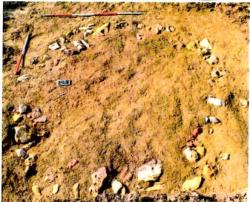 Cambes -Le conseil communautaire du 26 septembre a acté le financement d'une campagne de fouilles archéologiques préventives aux lieux-dits les Trouvats et Blancardie, sur le site de Quercypôle. Si sur les causses lotois il est relativement fréquent de rencontrer un tumulus abritant une ou plusieurs sépultures, il est par contre très rare de mettre au jour des vestiges du type des nécropoles à incinération de l'âge du bronze ou du premier âge du fer. L'équipe de Guillaume Clamens, responsable d'opération de la cellule départementale d'archéologie, a procédé à treize sondages et la principale découverte a été celle d'un aménagement circulaire avoisinant les 4 m de diamètre, composé de blocs calcaires et de grès, circonscrivant une fosse probablement sépulcrale. Selon Guillaume Clamens, «la vocation funéraire de cette structure semble l'hypothèse la plus pertinente en comparaison avec d'autres sites connus… Il est par ailleurs plausible que cette tombe ne soit pas seule mais s'inscrive dans le cadre d'une nécropole à incinération». Suite à la prescription de la Drac, la campagne de fouilles archéologiques qui va débuter devra notamment déterminer si le site de Cambes peut être rapproché du site tarnais de la Gourjade, à Castres, où plus de 400 tombes à incinération datées de la fin de l'âge du bronze au milieu du premier âge du fer ont été mises au jour.
Cambes -Le conseil communautaire du 26 septembre a acté le financement d'une campagne de fouilles archéologiques préventives aux lieux-dits les Trouvats et Blancardie, sur le site de Quercypôle. Si sur les causses lotois il est relativement fréquent de rencontrer un tumulus abritant une ou plusieurs sépultures, il est par contre très rare de mettre au jour des vestiges du type des nécropoles à incinération de l'âge du bronze ou du premier âge du fer. L'équipe de Guillaume Clamens, responsable d'opération de la cellule départementale d'archéologie, a procédé à treize sondages et la principale découverte a été celle d'un aménagement circulaire avoisinant les 4 m de diamètre, composé de blocs calcaires et de grès, circonscrivant une fosse probablement sépulcrale. Selon Guillaume Clamens, «la vocation funéraire de cette structure semble l'hypothèse la plus pertinente en comparaison avec d'autres sites connus… Il est par ailleurs plausible que cette tombe ne soit pas seule mais s'inscrive dans le cadre d'une nécropole à incinération». Suite à la prescription de la Drac, la campagne de fouilles archéologiques qui va débuter devra notamment déterminer si le site de Cambes peut être rapproché du site tarnais de la Gourjade, à Castres, où plus de 400 tombes à incinération datées de la fin de l'âge du bronze au milieu du premier âge du fer ont été mises au jour.
http://www.ladepeche.fr/article/2014/10/04/1964885-des-fouilles-archeologiques.html
TURQUIE – 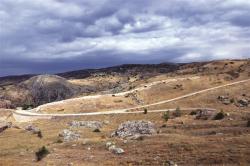 Hattuşa - Archaeologists have unearthed part of the 3,700-year-old city wall of Hattuşa, capital city of the ancient Hittites, in the northern province of Çorum. The Hittites had built the 4.5-kilometer city walls to protect their capital Hattuşa. “The city walls were first unearthed during the first year of excavations between 1906 and 1907. Some 700 meters of the 4.5-kilometer-long city walls have been unearthed. We worked for the restoration of 400-meter parts of the walls over the last three years. These walls were the first big project of the Hittites. The wall surrounds the whole city,” said Dr. Andreas Schachner, who is caryring out the excavations for the German Archaeological Institute, noting that their most recent archaeological work had focused on restoring the walls. Schachner said they had also discovered 10 underground tunnels in some parts of the wall. “These tunnels were made for soldiers to leave the city in secret during an attack or occupation and fight. There is a tower in every 20-25 kilometer of the walls. The Hittites built the walls on an artificial hill to show the city’s power and magnificence,” he said. He said the city walls were 10 meters high when they were built but later fell to five-six meters.
Hattuşa - Archaeologists have unearthed part of the 3,700-year-old city wall of Hattuşa, capital city of the ancient Hittites, in the northern province of Çorum. The Hittites had built the 4.5-kilometer city walls to protect their capital Hattuşa. “The city walls were first unearthed during the first year of excavations between 1906 and 1907. Some 700 meters of the 4.5-kilometer-long city walls have been unearthed. We worked for the restoration of 400-meter parts of the walls over the last three years. These walls were the first big project of the Hittites. The wall surrounds the whole city,” said Dr. Andreas Schachner, who is caryring out the excavations for the German Archaeological Institute, noting that their most recent archaeological work had focused on restoring the walls. Schachner said they had also discovered 10 underground tunnels in some parts of the wall. “These tunnels were made for soldiers to leave the city in secret during an attack or occupation and fight. There is a tower in every 20-25 kilometer of the walls. The Hittites built the walls on an artificial hill to show the city’s power and magnificence,” he said. He said the city walls were 10 meters high when they were built but later fell to five-six meters.
http://www.hurriyetdailynews.com/hattusas-city-walls-come-to-light.aspx?pageID=238&nid=72611&NewsCatID=375